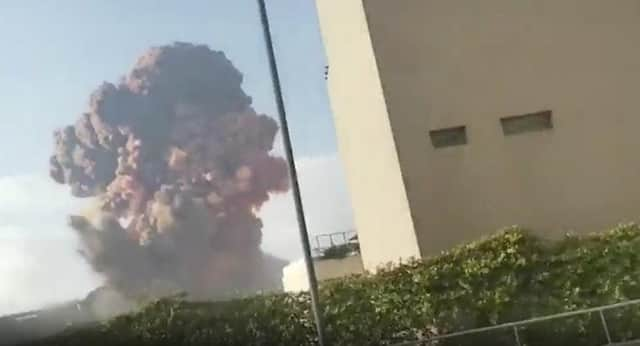Sheffield experts confirm Beirut explosion one of 'largest non-nuclear blasts in history'


A Sheffield team has calculated the strength of the blast based on the videos and photographs which have emerged since Tuesday’s catastrophe.
They believe the explosion was the equivalent of 1,000 to 1,500 tonnes of TNT – a blast intensity which would support the belief that it was caused by a fire leading to the detonation of 2,750 tonnes of ammonium nitrate fertiliser.
Advertisement
Hide AdAdvertisement
Hide AdThis is about a tenth of the intensity of the Hiroshima nuclear bomb but far bigger than any blast from a conventional weapon.
Professor Andy Tyas, an expert on blast protection engineering at the university, said: “There are simple rules of thumb relating the maximum expansion of the fireball to the size of the original explosive charge, and from some very approximate measurements from online video footage, we think the explosion is equivalent to something of the order of 1,000-1,500 tonnes of TNT.
“We have also analysed video footage of the time delay between the detonation and the arrival of the shock wave at points several hundred metres from the explosion and these broadly agree with this size of charge.
“If correct, that would mean this explosion had perhaps 10 per cent of the intensity of the Hiroshima bomb.
Advertisement
Hide AdAdvertisement
Hide Ad“Whatever the precise charge size, this is unquestionably one of the largest non-nuclear explosions in history, far bigger than any conventional weapon.
“The effects of an event like this are catastrophic to people, infrastructure, economic livelihoods and to the environment.”
Prof Tyas’s team studies the mechanisms and magnitudes of blast wave loading from high explosive detonations and their effects on structures.
He said: “If the figure of around 1,000 to 1,500 tonnes is correct, it would match with reports that the explosion was caused by a fire leading to the detonation of 2,750 tonnes of ammonium nitrate fertiliser.”
Prof Tyas said the blast wave from a detonation of this size would produce lethal injuries and severe damage to unreinforced buildings for several hundred metres.
Comment Guidelines
National World encourages reader discussion on our stories. User feedback, insights and back-and-forth exchanges add a rich layer of context to reporting. Please review our Community Guidelines before commenting.